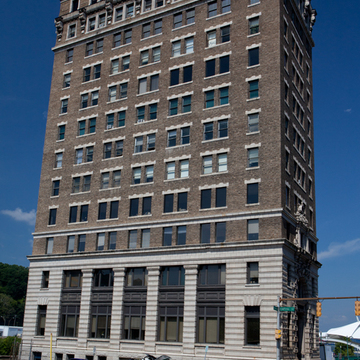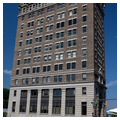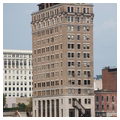You are here
Union Building (Alderson–Stephenson Building)
Once the tallest office building in West Virginia, this early high rise was financed by the two Charlestonians whose hyphenated names it originally bore. The Washington, D.C., partnership that designed the building arranged its twelve stories in a traditional pattern of base, shaft, and capital. Manufacturers Record (June 3, 1909) reported that, since all four sides of the freestanding building were easily visible (the rear from across the river), it was “finished on all alike, thus presenting a perfect appearance, no matter where the viewpoint.” The first two stories are clad in granite blocks, and those above are sheathed in buff brick. The recessed entrance is handsomely framed as a classical triumphal arch. Between windows of the eleventh floor, huge consoles formerly supported a classical Corinthian cornice, fabricated of copper. The consoles remain, but the cornice has been removed. The building's appearance reveals nothing of its unusual construction, which was dictated in part by its riverfront site. Manufacturers Record (August 25, 1910) reported that the thirty-two concrete piers supporting the steel frame rest on solid rock, extending 64 feet through 18 feet of quicksand.
The main interior space was originally the home of Charleston's Union Trust Company, and the structure is now generally known as the Union Building. It continues in use as an office building and is one of downtown's most familiar landmarks. In 1938–1940 Kanawha Boulevard separated it from the rest of the commercial district, and the building now stands in isolated splendor along the riverfront.
Writing Credits
If SAH Archipedia has been useful to you, please consider supporting it.
SAH Archipedia tells the story of the United States through its buildings, landscapes, and cities. This freely available resource empowers the public with authoritative knowledge that deepens their understanding and appreciation of the built environment. But the Society of Architectural Historians, which created SAH Archipedia with University of Virginia Press, needs your support to maintain the high-caliber research, writing, photography, cartography, editing, design, and programming that make SAH Archipedia a trusted online resource available to all who value the history of place, heritage tourism, and learning.

















